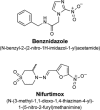Chagas' disease: an update on immune mechanisms and therapeutic strategies
- PMID: 20070438
- PMCID: PMC3829005
- DOI: 10.1111/j.1582-4934.2010.01007.x
Chagas' disease: an update on immune mechanisms and therapeutic strategies
Abstract
* Introduction * Chagas' disease * Chemotherapy * Immune response in experimental T. cruzi infection * Immune response in human beings infected with T. cruzi * Immune response in the treatment of chagasic infection * The need for new therapeutic alternatives for Chagas' disease * Conclusions The final decade of the 20th century was marked by an alarming resurgence in infectious diseases caused by tropical parasites belonging to the kinetoplastid protozoan order. Among the pathogenic trypanosomatids, some species are of particular interest due to their medical importance. These species include the agent responsible for Chagas' disease, Trypanosoma cruzi. Approximately 8 to 10 million people are infected in the Americas, and approximately 40 million are at risk. In the present review, we discuss in detail the immune mechanisms elicited during infection by T. cruzi and the effects of chemotherapy in controlling parasite proliferation and on the host immune system.
Figures



Similar articles
-
[Immune response to Trypanosoma cruzi. An approach to the pathogenesis of Chagas' disease].Acta Physiol Pharmacol Latinoam. 1985;35(1):1-47. Acta Physiol Pharmacol Latinoam. 1985. PMID: 2932884 Spanish.
-
A Trypanosoma cruzi small surface molecule provides the first immunological evidence that Chagas' disease is due to a single parasite lineage.J Exp Med. 2002 Feb 18;195(4):401-13. doi: 10.1084/jem.20011433. J Exp Med. 2002. PMID: 11854354 Free PMC article.
-
Humoral and cellular immune response of adults from northeastern Brazil with chronic Trypanosoma cruzi infection: depressed cellular immune response to T. cruzi antigen among Chagas' disease patients with symptomatic versus indeterminate infection.Am J Trop Med Hyg. 1993 Sep;49(3):370-82. doi: 10.4269/ajtmh.1993.49.370. Am J Trop Med Hyg. 1993. PMID: 8372959
-
Trypanosoma cruzi-induced molecular mimicry and Chagas' disease.Curr Top Microbiol Immunol. 2005;296:89-123. doi: 10.1007/3-540-30791-5_6. Curr Top Microbiol Immunol. 2005. PMID: 16323421 Review.
-
Is It Possible to Intervene in the Capacity of Trypanosoma cruzi to Elicit and Evade the Complement System?Front Immunol. 2021 Dec 16;12:789145. doi: 10.3389/fimmu.2021.789145. eCollection 2021. Front Immunol. 2021. PMID: 34975884 Free PMC article. Review.
Cited by
-
Trypanosoma cruzi Reactivation After Chimeric Antigen Receptor T-Cell Therapy.Open Forum Infect Dis. 2024 Jan 23;11(1):ofad698. doi: 10.1093/ofid/ofad698. eCollection 2024 Jan. Open Forum Infect Dis. 2024. PMID: 38264096 Free PMC article.
-
The phosphoarginine energy-buffering system of trypanosoma brucei involves multiple arginine kinase isoforms with different subcellular locations.PLoS One. 2013 Jun 11;8(6):e65908. doi: 10.1371/journal.pone.0065908. Print 2013. PLoS One. 2013. PMID: 23776565 Free PMC article.
-
Trypanosoma cruzi evades the protective role of interferon-gamma-signaling in parasite-infected cells.PLoS One. 2014 Oct 23;9(10):e110512. doi: 10.1371/journal.pone.0110512. eCollection 2014. PLoS One. 2014. PMID: 25340519 Free PMC article.
-
Therapeutic effects of sphingosine kinase inhibitor N,N-dimethylsphingosine (DMS) in experimental chronic Chagas disease cardiomyopathy.Sci Rep. 2017 Jul 21;7(1):6171. doi: 10.1038/s41598-017-06275-z. Sci Rep. 2017. PMID: 28733584 Free PMC article.
-
Vaccination With Recombinant Filamentous fd Phages Against Parasite Infection Requires TLR9 Expression.Front Immunol. 2018 May 29;9:1173. doi: 10.3389/fimmu.2018.01173. eCollection 2018. Front Immunol. 2018. PMID: 29896197 Free PMC article.
References
-
- Alves MJ, Colli W. Trypanosoma cruzi: adhesion to the host cell and intracellular survival. IUBMB Life. 2007;59:274–9. - PubMed
-
- Punukollu G, Gowda RM, Khan IA, et al. Clinical aspects of the Chagas’ heart disease. Int J Cardiol. 2007;115:279–83. - PubMed
-
- Moncayo A, Ortiz Yanine MI. An update on Chagas disease (human American trypanosomiasis) Ann Trop Med Parasitol. 2006;100:663–77. - PubMed
-
- Gattuso JM, Kamm MA. The management of constipation in adults. Aliment Pharmacol Ther. 1993;7:487–500. - PubMed
Publication types
MeSH terms
LinkOut - more resources
Full Text Sources
Other Literature Sources
Medical

